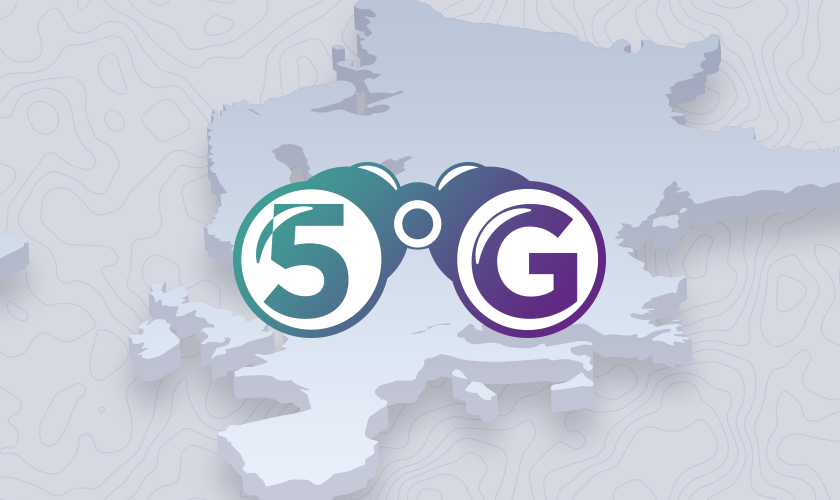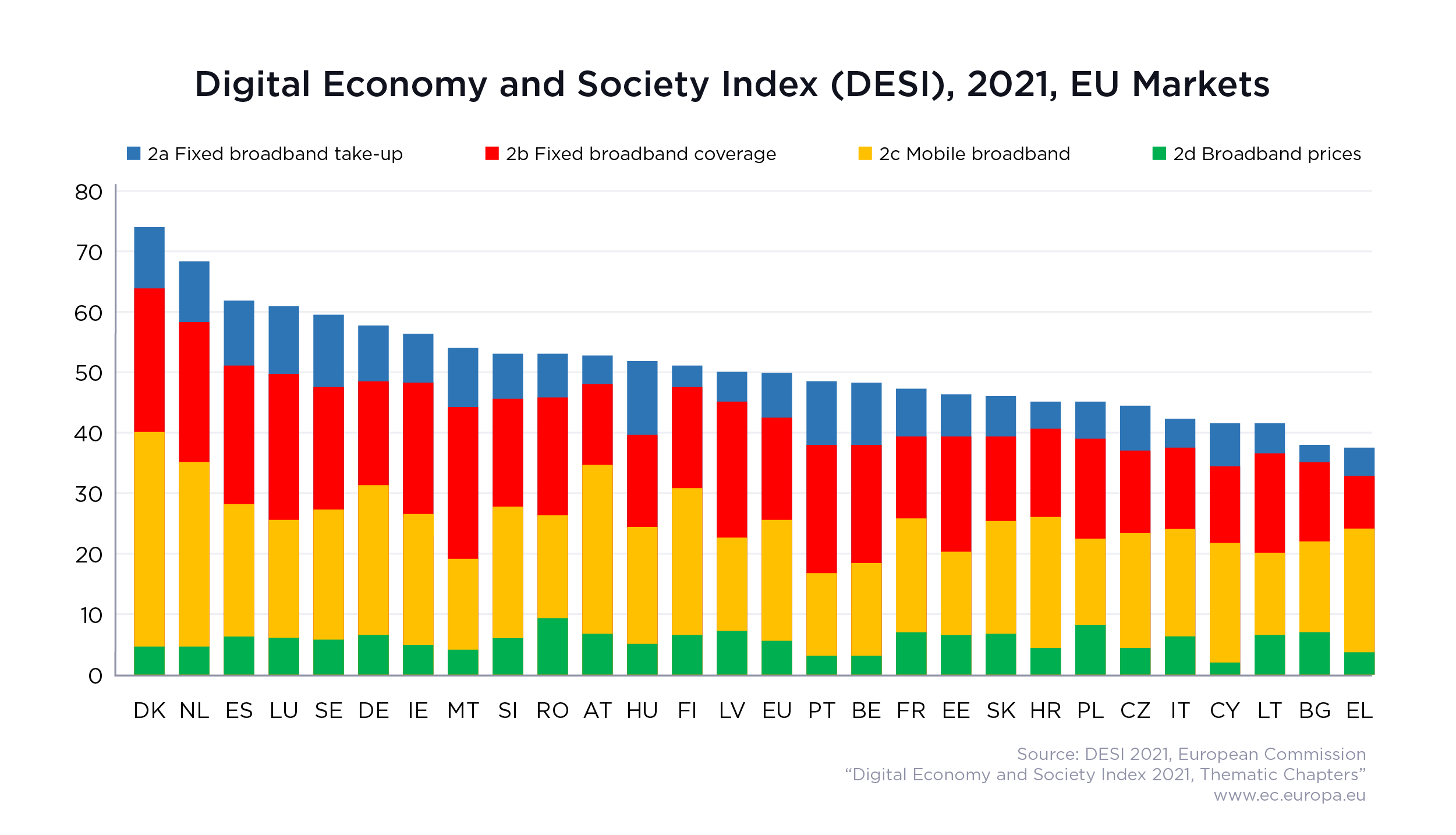Summer is here and with it the August vacation season that most of Europe has been waiting for. We’re here with fresh data from Speedtest Intelligence® to help you know in advance if your phone will be a help or a hindrance on your travels. We’ve examined results from Android devices in the European Union (EU) and the United Kingdom (U.K.) during Q2 2023 and included data on 5G performance to see if “Roam Like at Home” is living up to its promise.
5G boosts European roaming speeds but latency varies
Speed and latency are two important indicators of online performance. Speed will have a greater effect on streaming content while latency will affect gaming and video chatting. Both come into play while browsing online maps for that hot new gelato place your friends told you about.
While the EU extended “Roam Like at Home” regulations until 2032, our previous analyses demonstrated that mobile speeds are usually slower when roaming than when exploring your home country. The actual speeds vary dramatically based on roaming agreements between mobile operators, something you can’t really control unless you’re prepared to do the research then shop for a whole new plan before your trip. What you can control is whether you spring for 5G before your big trip. The data below represents the local speeds and multi-server latency for each country as well as those experienced by residents of the named country while roaming in the EU or the U.K. during Q2 2023.
Roaming speeds can’t live up to local performance
Median Mobile Roaming Performance in Europe
Speedtest IntelligenceⓇ | Q2 2023
| Country | Local Download (Mbps) | Roaming Download (Mbps) | Local 5G Download (Mbps) | Roaming 5G Download (Mbps) |
|---|---|---|---|---|
| Austria | 59.28 | 42.77 | 161.00 | 80.51 |
| Belgium | 48.00 | 59.86 | 157.23 | 124.64 |
| Bulgaria | 78.27 | 48.97 | 252.75 | 93.24 |
| Croatia | 73.65 | 47.86 | 184.29 | 124.38 |
| Cyprus | 56.93 | 40.83 | 197.22 | 64.24 |
| Czechia | 46.50 | 31.96 | 104.36 | 72.26 |
| Denmark | 118.48 | 51.74 | 206.95 | 115.82 |
| Estonia | 64.99 | 77.51 | * | * |
| Finland | 78.00 | 53.43 | 217.13 | 106.54 |
| France | 61.64 | 43.46 | 187.42 | 95.56 |
| Germany | 46.30 | 39.54 | 114.07 | 84.27 |
| Greece | 57.41 | 66.17 | 143.26 | 153.28 |
| Hungary | 40.44 | 48.28 | 85.12 | 132.98 |
| Ireland | 34.49 | 36.10 | 98.70 | 85.38 |
| Italy | 36.97 | 37.68 | 130.85 | 99.38 |
| Latvia | 59.73 | 65.13 | 220.51 | 146.15 |
| Lithuania | 64.70 | 53.04 | * | * |
| Luxembourg | 74.86 | 46.88 | * | * |
| Malta | 44.56 | 48.11 | 109.97 | 110.80 |
| Netherlands | 96.77 | 37.61 | 128.04 | 87.84 |
| Poland | 42.14 | 34.23 | 78.82 | 99.51 |
| Portugal | 57.86 | 39.91 | 212.95 | 79.88 |
| Romania | 43.34 | 59.59 | 153.35 | 99.84 |
| Slovakia | 43.16 | 41.53 | 139.53 | 85.16 |
| Slovenia | 52.73 | 49.86 | 145.83 | 95.50 |
| Spain | 32.33 | 35.77 | 85.75 | 116.48 |
| Sweden | 84.00 | 51.24 | 160.93 | 129.43 |
| United Kingdom | 40.74 | 48.06 | 108.74 | 98.92 |
Although EU residents can roam call, text, and surf without additional charges, a drop in speed is an issue while roaming according to Q2 2023 data. Residents from 17 countries showed faster local download speeds than roaming speeds when considering results over all technologies during Q2 2023. The 11 exceptions were Romania (which was much faster roaming), Belgium, Hungary, Estonia, the U.K, Greece, and Spain, which all showed faster roaming speeds, and Latvia, Malta, Ireland, and Italy which showed only slightly improved speeds.
While roaming speeds varied widely based on country of origin, every country on this list saw much higher median download speeds when roaming on 5G than roaming on all technologies. Despite this uplift, 20 countries showed faster local 5G download speeds than roaming 5G speeds during Q2 2023. The exceptions were Hungary, Spain, and Poland, which all saw faster 5G roaming than locally, while Greece had marginally better 5G roaming than at home, and people from Malta didn’t really see any major difference. Estonia, Lithuania, and Luxembourg did not have enough 5G samples to qualify for analysis.
Latency suffers awfully when roaming
Median Mobile Roaming Latency in Europe
Speedtest IntelligenceⓇ | Q2 2023
| Country | Local Multi-server Latency (ms) | Roaming Multi-server Latency (ms) | Local 5G Multi-server Latency (ms) | 5G Multi-server Latency (ms) |
|---|---|---|---|---|
| Austria | 32.19 | 91.24 | 30.96 | 111.08 |
| Belgium | 36.51 | 84.96 | 31.89 | 67.61 |
| Bulgaria | 31.72 | 125.60 | 26.41 | 124.63 |
| Croatia | 39.03 | 85.25 | 35.96 | 80.37 |
| Cyprus | 27.90 | 200.18 | 23.52 | 184.68 |
| Czechia | 34.72 | 80.18 | 30.77 | 78.72 |
| Denmark | 29.47 | 94.77 | 28.08 | 81.85 |
| Estonia | 33.10 | 87.00 | * | * |
| Finland | 33.67 | 102.84 | 32.16 | 99.14 |
| France | 46.97 | 92.61 | 44.39 | 87.49 |
| Germany | 41.78 | 87.19 | 39.07 | 77.57 |
| Greece | 38.16 | 137.29 | 34.63 | 132.91 |
| Hungary | 36.27 | 85.39 | 35.06 | 77.26 |
| Ireland | 36.21 | 116.62 | 31.70 | 118.47 |
| Italy | 50.87 | 100.20 | 49.96 | 93.87 |
| Latvia | 29.88 | 101.91 | 26.28 | 94.70 |
| Lithuania | 34.03 | 107.79 | * | * |
| Luxembourg | 33.45 | 67.70 | * | * |
| Malta | 47.44 | 146.57 | 38.69 | 135.43 |
| Netherlands | 33.24 | 83.25 | 31.17 | 79.81 |
| Poland | 42.41 | 108.69 | 40.25 | 100.36 |
| Portugal | 35.98 | 123.05 | 31.62 | 126.54 |
| Romania | 40.65 | 122.91 | 34.22 | 121.21 |
| Slovakia | 30.47 | 80.28 | 26.39 | 70.96 |
| Slovenia | 30.61 | 76.68 | 27.70 | 75.27 |
| Spain | 51.53 | 112.81 | 47.11 | 102.94 |
| Sweden | 37.52 | 114.69 | 32.97 | 99.48 |
| United Kingdom | 50.45 | 111.01 | 46.04 | 107.59 |
Residents of every country surveyed had a much higher multi-server latency when roaming during Q2 2023. This is because roaming signals are routed through a user’s home network, making latency a significant issue for Europeans when traveling. The difference was smallest in Italy and France where locals had about a 97% higher latency when roaming compared to at home. On the other end of the scale, residents of Cyprus saw over a 615% higher latency while roaming compared to at home. A high latency means a long response time for any request you send over the internet, perhaps adding more frustration to your vacation than you would want.
The results were similar over 5G with Italy showing the smallest difference between latency while roaming and at home (about 88% greater) and Cyprus having the largest difference (about 685%). Surprisingly, 5G did not reliably improve multi-server latency.
What this data tells you is that it’s worth upgrading to 5G before a trip if speed is your main concern. Whether 5G will help you with your latency will depend heavily on which country you are traveling from. Regardless, you should expect a high latency while roaming. Plan ahead accordingly.
Outbound roaming speeds vary dramatically
As discussed above, roaming speeds depend heavily on where you are traveling from, where you are traveling to, and what agreements your home mobile operator has with operators in the country you’re visiting. That said, it’s fun to look at what’s possible, so we looked at the very best and very worst roaming speeds in Europe during Q2 2023.
Fastest roaming speeds in Europe
Customers from Italy roaming in Portugal saw one of the fastest median roaming download speeds over 5G in all of Europe during Q2 2023 at 317.94 Mbps. Estonians roaming in Finland saw a 278.69 Mbps median 5G download speed, and Finns in Sweden experienced a median 5G download of 252.57 Mbps.
Looking at the highest results from all technologies combined, Latvians roaming in Finland experienced a median download speed of 137.49 Mbps, while Greeks saw median download speeds of 129.75 while roaming in Bulgaria and 125.83 Mbps while roaming in Austria.
Slowest roaming speeds in Europe
On the other end of the scale, Slovakian visitors to Poland had one of the slowest median download speeds over all technology while roaming during the same time period at 10.82 Mbps. Polish roamers saw a median download speed of 13.27 Mbps in the U.K. and 14.78 Mbps in Romania. Ten of the 20 slowest roaming speeds on our country-by-country list for all technologies were for Europeans roaming in the U.K. This means that travelers going to the U.K are not only seeing poorer performance, they could also be paying more for the privilege as they do not benefit from “Roam Like at Home” regulations.
Germans in Italy had the slowest median 5G download speed on our list during Q2 2023 at 33.64 Mbps. Austrians in the U.K. saw a median download speed over 5G of 41.57 Mbps, and Portuguese roamers in Spain experienced a median download speed over 5G of 44.18 Mbps.
Whether you choose to roam, pick up a local SIM or eSIM, or simply spend less time online, we hope this information helps you make the most of your vacation. If you have an extra minute between activities, take a Speedtest® to see how your performance compares.
Ookla retains ownership of this article including all of the intellectual property rights, data, content graphs and analysis. This article may not be quoted, reproduced, distributed or published for any commercial purpose without prior consent. Members of the press and others using the findings in this article for non-commercial purposes are welcome to publicly share and link to report information with attribution to Ookla.








